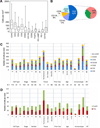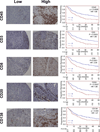Immunotype and immunohistologic characteristics of tumor-infiltrating immune cells are associated with clinical outcome in metastatic melanoma
- PMID: 22266112
- PMCID: PMC3306813
- DOI: 10.1158/0008-5472.CAN-11-3218
Immunotype and immunohistologic characteristics of tumor-infiltrating immune cells are associated with clinical outcome in metastatic melanoma
Abstract
Immune cells infiltrating the microenvironment of melanoma metastases may either limit or promote tumor progression, but the characteristics that distinguish these effects are obscure. In this study, we systematically evaluated the composition and organization of immune cells that infiltrated melanoma metastases in human patients. Three histologic patterns of immune cell infiltration were identified, designated immunotypes A, B, and C. Immunotype A was characterized by no immune cell infiltrate. Immunotype B was characterized by infiltration of immune cells limited only to regions proximal to intratumoral blood vessels. Immunotype C was characterized by a diffuse immune cell infiltrate throughout a metastatic tumor. These immunotypes represented 29%, 63%, and 8% of metastases with estimated median survival periods of 15, 23, and 130 months, respectively. Notably, from immunotypes A to C, there were increasing proportions of B cells and decreasing proportions of macrophages. Overall, the predominant immune cells were T cells (53%), B cell lineage cells (33%), and macrophages (13%), with natural killer and mature dendritic cells only rarely present. Whereas higher densities of CD8(+) T cells correlated best with survival, a higher density of CD45(+) leukocytes, T cells, and B cells also correlated with increased survival. Together, our findings reveal striking differences in the immune infiltrate in melanoma metastases in patients, suggesting microenvironmental differences in immune homing receptors and ligands that affect immune cell recruitment. These findings are important, not only by revealing how the immune microenvironment can affect outcomes but also because they reveal characteristics that may help improve individualized therapy for patients with metastatic melanoma.
Conflict of interest statement
Conflicts of interest related to this study: None.
Figures




Similar articles
-
[Prognostic value of tumor-infiltrating immune cells in melanoma].Magy Onkol. 2013 Jun;57(2):85-95. Epub 2013 Apr 3. Magy Onkol. 2013. PMID: 23795353 Review. Hungarian.
-
Prognostic impact of B-cell density in cutaneous melanoma.Cancer Immunol Immunother. 2011 Dec;60(12):1729-38. doi: 10.1007/s00262-011-1071-x. Epub 2011 Jul 21. Cancer Immunol Immunother. 2011. PMID: 21779876 Free PMC article.
-
Tumor PD-L1 expression, immune cell correlates and PD-1+ lymphocytes in sentinel lymph node melanoma metastases.Mod Pathol. 2015 Dec;28(12):1535-44. doi: 10.1038/modpathol.2015.110. Epub 2015 Sep 25. Mod Pathol. 2015. PMID: 26403784
-
Patterns of immune-cell infiltration in murine models of melanoma: roles of antigen and tissue site in creating inflamed tumors.Cancer Immunol Immunother. 2019 Jul;68(7):1121-1132. doi: 10.1007/s00262-019-02345-5. Epub 2019 May 27. Cancer Immunol Immunother. 2019. PMID: 31134297 Free PMC article.
-
Characteristics of Tumor-Infiltrating Lymphocytes Prior to and During Immune Checkpoint Inhibitor Therapy.Front Immunol. 2020 Mar 4;11:364. doi: 10.3389/fimmu.2020.00364. eCollection 2020. Front Immunol. 2020. PMID: 32194568 Free PMC article. Review.
Cited by
-
Human cutaneous B cells: what do we really know?Ann Transl Med. 2021 Mar;9(5):440. doi: 10.21037/atm-20-5185. Ann Transl Med. 2021. PMID: 33842661 Free PMC article. Review.
-
Oncolytic Vaccinia Virus Gene Modification and Cytokine Expression Effects on Tumor Infection, Immune Response, and Killing.Mol Cancer Ther. 2021 Aug;20(8):1481-1494. doi: 10.1158/1535-7163.MCT-20-0863. Epub 2021 May 27. Mol Cancer Ther. 2021. PMID: 34045231 Free PMC article.
-
Tumor stroma and chemokines control T-cell migration into melanoma following Temozolomide treatment.Oncoimmunology. 2015 Feb 25;4(2):e978709. doi: 10.4161/2162402X.2014.978709. eCollection 2015 Feb. Oncoimmunology. 2015. PMID: 25949877 Free PMC article.
-
Nivolumab for advanced melanoma: pretreatment prognostic factors and early outcome markers during therapy.Oncotarget. 2016 Nov 22;7(47):77404-77415. doi: 10.18632/oncotarget.12677. Oncotarget. 2016. PMID: 27764805 Free PMC article.
-
Profiling networks of distinct immune-cells in tumors.BMC Bioinformatics. 2016 Jul 4;17(1):263. doi: 10.1186/s12859-016-1141-3. BMC Bioinformatics. 2016. PMID: 27377892 Free PMC article.
References
-
- Galon J, Costes A, Sanchez-Cabo F, Kirilovsky A, Mlecnik B, Lagorce-Pages C, et al. Type, density, and location of immune cells within human colorectal tumors predict clinical outcome. Science. 2006;313:1960–1964. - PubMed
-
- Eerola AK, Soini Y, Paakko P. A high number of tumor-infiltrating lymphocytes are associated with a small tumor size, low tumor stage, and a favorable prognosis in operated small cell lung carcinoma. Clin Cancer Res. 2000;6:1875–1881. - PubMed
-
- Zhang L, Conejo-Garcia JR, Katsaros D, Gimotty PA, Massobrio M, Regnani G, et al. Intratumoral T cells, recurrence, and survival in epithelial ovarian cancer. N Engl J Med. 2003;348:203–213. - PubMed
Publication types
MeSH terms
Grants and funding
LinkOut - more resources
Full Text Sources
Other Literature Sources
Medical
Research Materials
Miscellaneous

